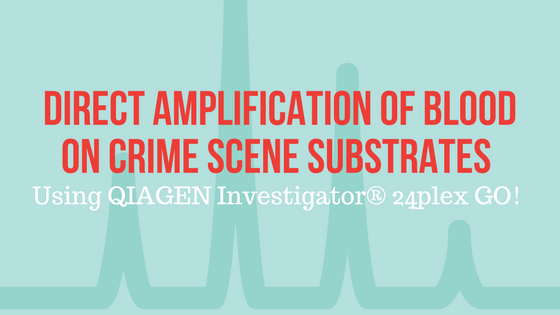Autosomal Short Tandem Repeat (STR) Analysis is a common molecular technique performed widely in forensic and genetic labs. STRs are short nucleotide DNA sequences that are repeated a specific number of times among individuals, and can easily be amplified by Polymerase Chain Reaction (PCR). This allows STR analysis to be an essential technique for human identification.
Body fluids, such as blood, are often found at crime scenes and can be found on various substrates such as fabrics and other materials. The body fluids deposited on the substrates may not amplify well because of inhibitors present, and can make it hard for the DNA analyst to produce a complete STR profile.
Written by: marcel Burton, Pennsylvania State University
The QIAGEN Investigator ® 24plex GO! Direct Amplification kit was evaluated to determine if complete STR profiles could be produced when blood is deposited on various crime scene substrates. The Investigator ®24plex GO! Direct Amplification kit identifies 22 autosomal loci and includes two internal PCR controls, QS1 and QS2. QS1 and QS2 provide information on whether inhibition and/or degradation are present in the sample.
Direct amplification was performed using the Investigator ®24plex GO! Direct Amplification kit. This differs from standard amplification in that extraction and quantification of DNA are not performed. Various substrates were utilized in this project to stimulate substrates often collected at crime scenes.
The 24plex GO! Lysis Buffer helped the samples overcome inhibition that could be present from the substrates. All substrates remained in the amplification tube during the amplification process. The protocol and parameters from the Investigator® 24plex Handbook were adjusted accordingly for the scope of this project.
Complete profiles were generated for blood samples amplified using the Investigator ®24plex GO! Direct Amplification kit, although inhibition was observed in some samples.
This research stemmed from previous laboratory work from Dr. Reena Roy’s research group at the Pennsylvania State University. Determining a sufficient protocol to use for direct amplification of blood on simulated crime scene substrates can provide an alternate method to the traditional standard amplification performed in crime labs today. STR analysis is an important technique in forensic science and it is important that research in this area is upheld to ensure productivity, and that is the main reason for development of this project.
It is a significant application for the field because standard amplification can be a time-consuming process, especially for smaller DNA laboratories. Direct amplification is quick and reproducible, and can help solve the issue of back log in forensic labs.
Further research is being pursued with direct amplification using simulated crime scene substrates on other body fluids. More research in this area will hopefully bring additional information to the field of forensic DNA analysis.
WOULD YOU LIKE TO SEE MORE ARTICLES LIKE THIS? SUBSCRIBE TO THE ISHI BLOG BELOW!
SUBSCRIBE NOW!


